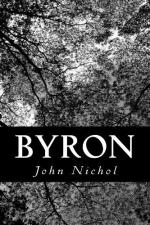During this period, 1813-1816, he had become familiar with all the phases of London society, “tasted their pleasures,” and, towards the close, “felt their decay.” His associates in those years were of two classes—men of the world, and authors. Feted and courted in all quarters, he patronized the theatres, became in 1815 a member of the Drury Lane Committee, “liked the dandies,” including Beau Brummell, and was introduced to the Regent. Their interview, in June 1812, in the course of which the latter paid unrestrained compliments to Harold and the poetry of Scott, is naively referred to by Mr. Moore “as reflecting even still more honour on the Sovereign himself than on the two poets.” Byron, in a different spirit, writes to Lord Holland: “I have now great hope, in the event of Mr. Pye’s decease, of warbling truth at Court, like Mr. Mallet of indifferent memory. Consider, one hundred marks a year! besides the wine and the disgrace.” We can hardly conceive the future author of the Vision of Judgment writing odes to dictation. He does not seem to have been much fascinated with the first gentleman of Europe, whom at no distant date he assailed in the terrible “Avatar,” and left the laureateship to Mr. Southey.
Among leaders in art and letters he was brought into more or less intimate contact with Sir Humphry Davy, the Edgeworths, Sir James Mackintosh, Colman the dramatic author, the older Kean, Monk Lewis, Grattan, Curran, and Madame de Stael. Of a meeting of the last two he remarks, “It was like the confluence of the Rhone and the Saone, and they were both so ugly that I could not help wondering how the best intellects of France and Ireland could have taken up respectively such residences.”
About this time a communication from Mr Murray in reference to the meeting with the Regent led to a letter from Sir Walter Scott to Lord Byron, the beginning of a life-long friendship, and one of the most pleasing pages of biography. These two great men were for a season perpetually pitted against one another, as the foremost competitors for literary favour. When Rokeby came out, contemporaneously with the Giaour, the undergraduates of Oxford and Cambridge ran races to catch the first copies, and laid bets as to which of the rivals would win. During the anti-Byronic fever of 1840-1860 they were perpetually contrasted as the representatives of the manly and the morbid schools. A later sentimentalism has affected to despise the work of both. The fact therefore that from an early period the men themselves knew each other as they were, is worth illustrating.




